The Government of Canada’s progress on greening procurement
As part of the Greening Government Strategy, the Government of Canada is aiding the transition to a net-zero, circular economy through green procurement.
The green procurement commitments outlined in the Greening Government Strategy support the Government of Canada’s:
- goal of net-zero emissions
- goal of establishing resilient internal operations
- commitment to transition Canada to a circular economy
The transition includes the use of life-cycle assessment principles and the adoption of clean technologies and green products and services. Examples of the transition include the purchase of:
- zero-emission light-duty vehicles
- clean electricity from renewable sources
- low-carbon fuels
Green procurement also encompasses:
- decisions about leased office space
- the use of structural materials that have low embodied carbon for major construction projects
- working with suppliers to reduce supply chain emissions
In addition to reporting on procurement commitments, the Greenhouse Gas Emissions Inventory pages on Canada.ca and on the Open Government portal provide information about greenhouse gas (GHG) emissions from federal facilities and fleets.
Progress
As outlined in the Greening Government Strategy, the Government of Canada is committed to greening multiple aspects of its operations, including procurement. Below is a summary of the progress towards the following targets:
- Starting in 2025, 100% of new light-duty fleet vehicle purchases will be zero-emissions vehicles where suitable options are available; for fiscal year 2023-24, the applicable target was at least 75% of new light-duty fleet vehicle purchases were to be zero-emission or hybrid electric vehicles.
- By 2030, the government’s light-duty fleet will be 100% zero-emission vehicles
- By 2025, use 100% clean electricity by producing or purchasing clean renewable electricity, where available
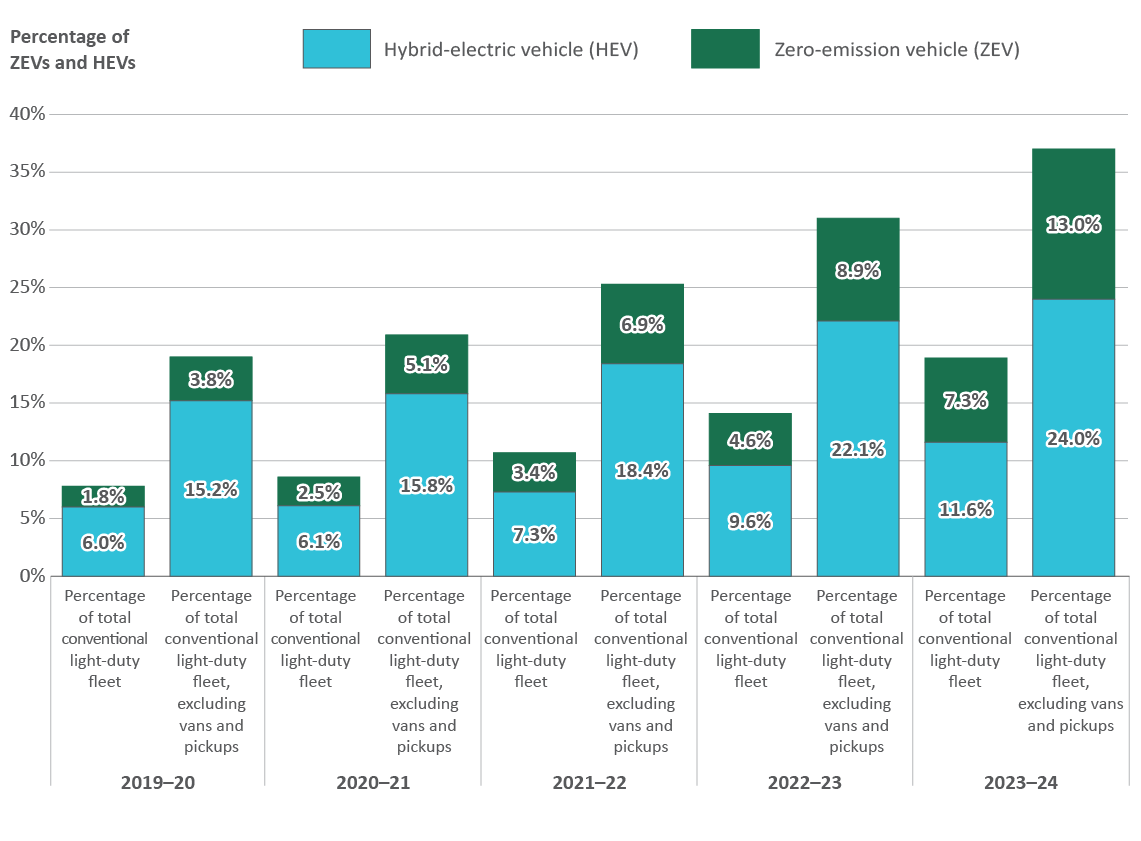
Figure 1 - Text version
For each fiscal year from 2019-20 to 2023-24, the bar graph shows the proportion of zero-emission and hybrid-electric vehicles as a percentage of the total number of vehicles in the conventional light-duty fleet. It also shows the proportion when excluding vans and pickups from the total number of vehicles in the conventional light-duty fleet. Green vehicle purchases are progressing well in the categories with high market availability (passenger cars and multi-purpose vehicles). Progress is slower in categories where there is limited market availability (vans and pickups, which account for 61% of the federal fleet). This situation is changing as more green van and pickup options become available and accelerated progress is expected.
| Fiscal year | Hybrid-electric vehicles as a percentage of the total conventional light-duty fleet | Hybrid-electric vehicles as a percentage of the conventional light-duty fleet, excluding vans and pickups | Zero-emission vehicles as a percentage of the total conventional light-duty fleet | Zero-emission vehicles as a percentage of the conventional light-duty fleet, excluding vans and pickups |
|---|---|---|---|---|
| 2019–20 | 6.0% | 15.2% | 1.8% | 3.8% |
| 2020–21 | 6.1% | 15.8% | 2.5% | 5.1% |
| 2021–22 | 7.3% | 18.4% | 3.4% | 6.9% |
| 2022–23 | 9.6% | 22.1% | 4.5% | 8.9% |
| 2023–24 | 11.6% | 24.0% | 7.3% | 13.0% |
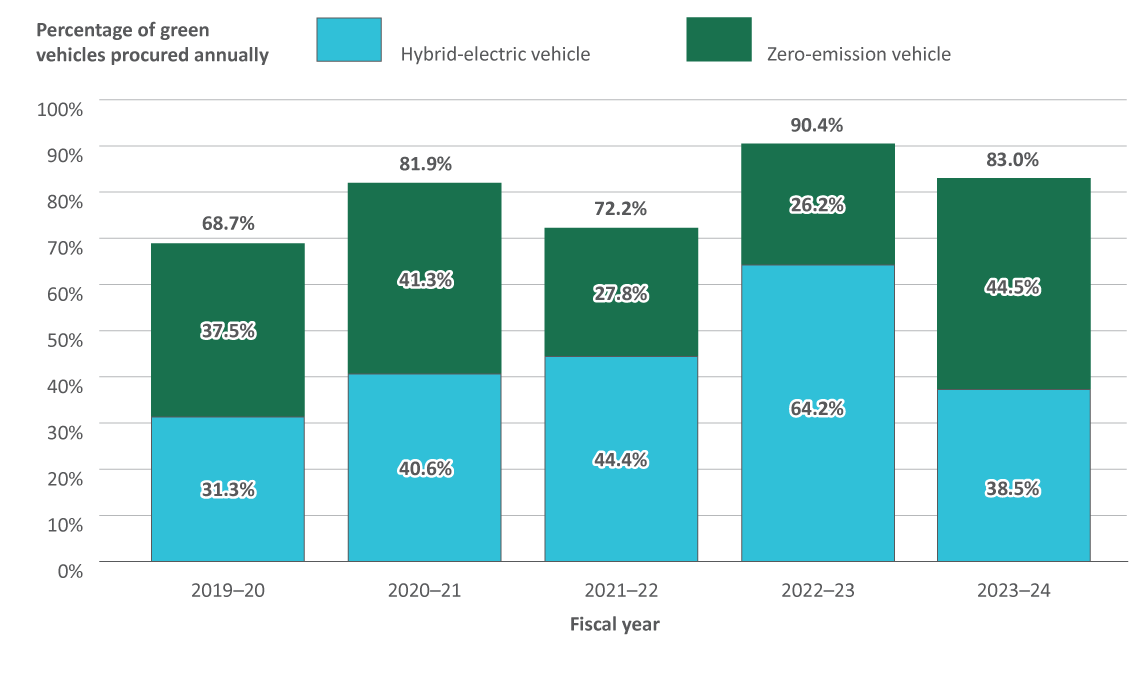
Figure 2 - Text version
For each fiscal year from 2019-20 to 2023-24, the bar graph shows the proportion of zero-emission and hybrid-electric vehicles purchased each year as a percentage of the total number of conventional light-duty vehicles purchased, where the target was applicable.
| Fiscal year | Hybrid-electric vehicles as a percentage of light-duty vehicles procured | Zero-emission vehicles as a percentage of light-duty vehicles procured | Green vehicles as percentage of light-duty vehicles procured |
|---|---|---|---|
| 2019–20 | 31.3% | 37.5% | 68.8% |
| 2020–21 | 40.6% | 41.3% | 81.9% |
| 2021–22 | 44.4% | 27.8% | 72.2% |
| 2022–23 | 64.2% | 26.2% | 90.4% |
| 2023–24 | 38.5% | 44.5% | 83.0% |
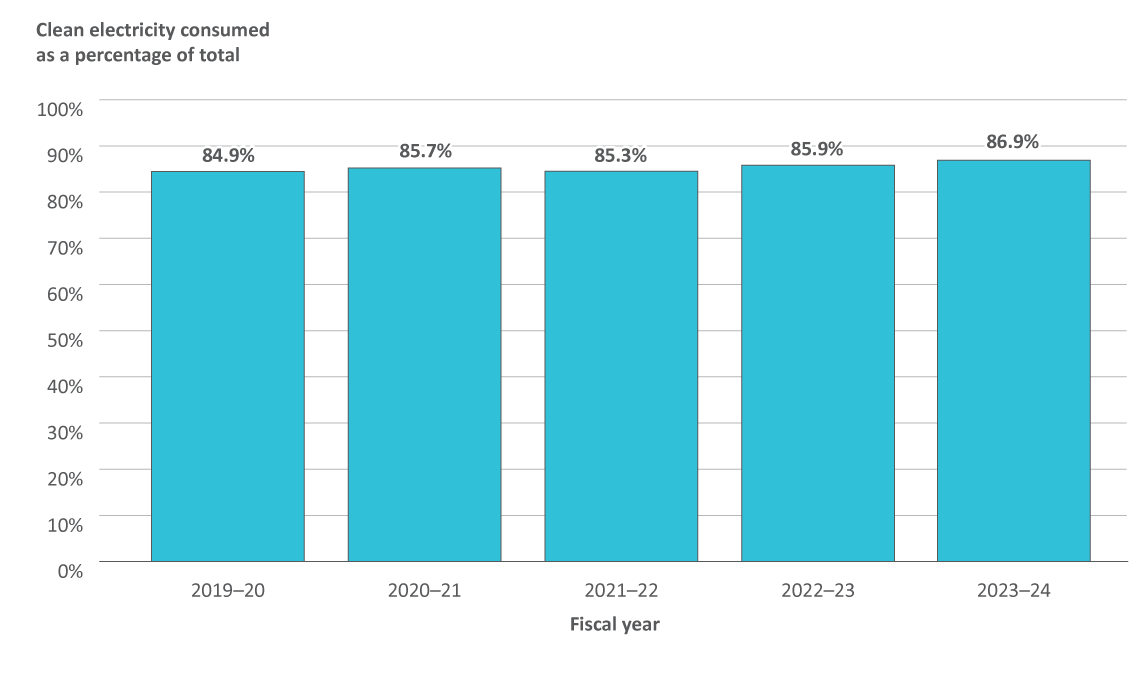
Figure 3 - Text version
For each fiscal year from 2019-20 to 2023-24, the bar graph shows the percentage of clean electricity consumed in federal operations. In this context, clean electricity comes from generation sources that do no emit greenhouse gases.
| Fiscal year | Clean electricity consumed as a percentage of the total electricity consumed by the federal government |
|---|---|
| 2019–20 | 84.9% |
| 2020–21 | 85.7% |
| 2021–22 | 85.3% |
| 2022–23 | 85.9% |
| 2023-24 | 86.9% |
Key results
- The proportion of green vehicles (hybrid-electric or zero-emission) in the Government of Canada’s light-duty conventional fleet continues to grow. The latest data show that the proportion has grown by 11.1% since 2019–20, reaching 18.9% in 2023–24. Of the green vehicles, 7.3% are zero-emission vehicles (ZEVs) and 11.6% are hybrid-electric vehicles (HEVs).
- The Government of Canada is adopting green vehicles at a faster pace than the national average for the Canadian market, as the most recent Statistics Canada data shows that only 3.9% of registered light-duty vehicles were green at the end of 2023.
- Green vehicle purchases are progressing well in the categories with high market availability (passenger cars and multi-purpose vehicles). Progress is slower in categories where there is limited market availability (vans and pickups, which account for 61% of the federal fleet). This situation is changing as more green van and pickup options are becoming available and accelerated progress in these segments is expected.
- The proportion of clean electricity consumed by the Government of Canada as a percentage of the total electricity consumed increased to 87% in 2023-24. Much of the increase can be attributed to increased procurement of renewable electricity certifications from new generation in Saskatchewan. This number will continue to increase as in-process clean electricity procurements in multiple jurisdictions are completed and new generating facilities come online.
Conventional light-duty land fleet
The Government of Canada is greening its on-road fleet by purchasing green vehicles wherever suitable options are available. These green purchases include hybrid-electric vehicles (HEVs) and zero-emission vehicles (ZEVs).
The federal government owns a wide variety of light-duty vehicles to support internal operations and deliver services to Canadians. Vehicles are used by:
- food inspectors and public health officials for site visits
- border officers to maintain security
- scientists and parks officers to study and protect our vast resources
Starting in 2025, 100% of new light-duty fleet vehicle purchases will be ZEVs, with the objective that the government’s light-duty fleet will be 100% ZEV by 2030. Until 2025, at least 75% of annual, new light-duty fleet vehicle purchases are to be ZEVs or HEVs. Priority is to be given to ZEVs, which include battery-electric, plug-in hybrid and hydrogen-fuel-cell electric vehicles.
These targets currently apply to the approximately 17,015 light-duty vehicles in the government’s conventional land fleet. The targets apply to new purchases where one or more suitable options per vehicle group are available that meet operational requirements. For example, there are currently many ZEV options available for smaller vehicles (passenger cars) but limited options for larger vehicles (vans, pickups). The conventional fleet also includes approximately 2,600 commercial medium- and heavy-duty vehicles and approximately 7,400 other off-road and industrial vehicles.
The government also operates a National Safety and Security Fleet (NSSF) which includes a land fleet that is composed of tactical vehicles operated by National Defence and the Royal Canadian Mounted Police. The NSSF land fleet includes approximately:
- 12,800 light-duty vehicles
- 8,000 standard military-pattern vehicles
- 2,000 commercial and other vehicles
The NSSF land fleet is subject to the net-zero emissions by 2050 target; however, the interim green vehicle targets do not apply due to the fleet’s unique operational requirements. NSSF organizations are currently developing plans to decarbonize operational fleets that will outline how they will reduce their emissions from operations in line with the overall 2050 target.
The following figures provide an overview of the conventional light-duty fleet and the progress toward targets.
For more information, refer to the:
- Greenhouse Gas Emissions Inventory page on the Open Government portal
- the Greening Government Strategy
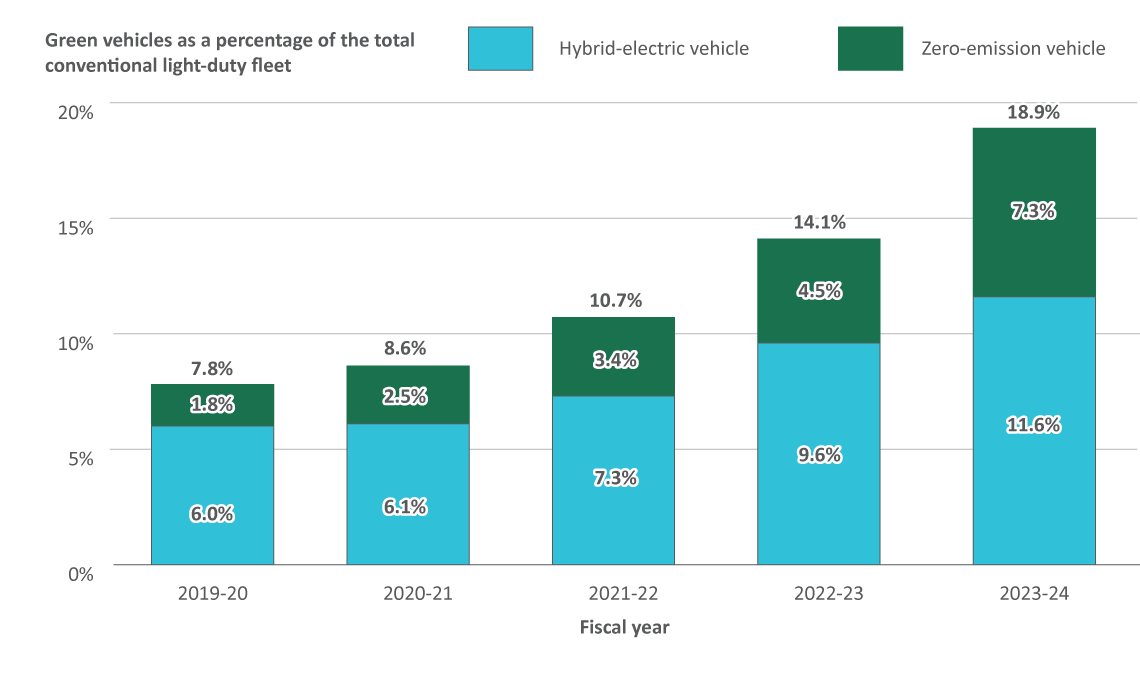
Figure 4 - Text version
For each fiscal year from 2019-20 to 2023-24, the bar graph shows the proportion of hybrid-electric vehicles (HEVs) and zero-emission vehicles (ZEVs) as a percentage of the total conventional light-duty fleet.
| Fiscal year | Hybrid-electric vehicles as a percentage of the total conventional light-duty fleet | Zero-emission vehicles as a percentage of the total conventional light-duty fleet | Green vehicles as a percentage of the total conventional light-duty fleet |
|---|---|---|---|
| 2019–20 | 6.0% | 1.8% | 7.8% |
| 2020–21 | 6.1% | 2.5% | 8.6% |
| 2021–22 | 7.3% | 3.4% | 10.7% |
| 2022-23 | 9.6% | 4.5% | 14.1% |
| 2023-24 | 11.6% | 7.3% | 18.9% |
| Federal organization | Number of internal combustion engine vehicles | Number of green vehicles |
|---|---|---|
| National Defence | 5,282 | 902 |
| Parks Canada | 1,483 | 295 |
| Correctional Service Canada | 1,158 | 417 |
| Fisheries and Oceans Canada | 1,183 | 195 |
| Canada Food Inspection Agency | 1,023 | 147 |
| Canada Border Services Agency | 927 | 216 |
| Environment and Climate Change Canada | 514 | 164 |
| Agriculture and Agri-Food Canada | 483 | 151 |
| Indigenous Services Canada | 381 | 52 |
| Transport Canada | 196 | 202 |
| All other organizations | 1,168 | 476 |
The annual target in 2023-24 was for 75% of all conventional light-duty vehicle purchases to be green. This target applies when suitable options are available that meet operational feasibility requirements.
Figure 5 shows the total number of purchases, the percentage of the total purchases for which the target applies, and the breakdown of the purchases that fall under the target. In 2023–24, where the target applied, 83.0% of vehicle purchases were green.
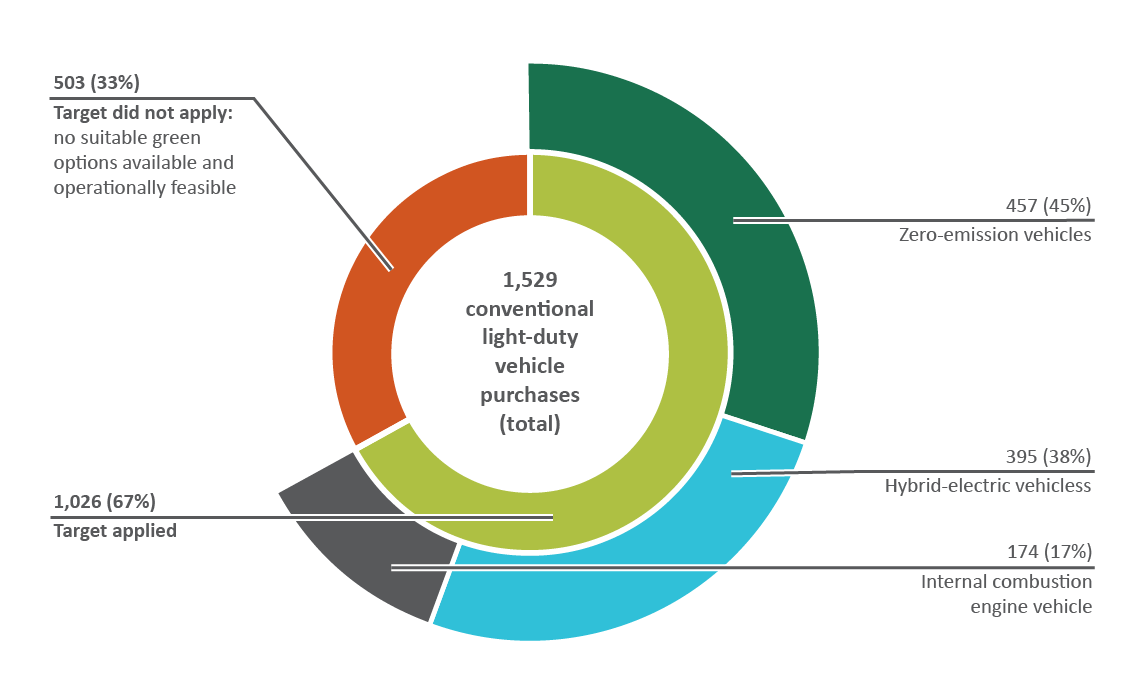
Figure 5 - Text version
The inner circle of the sunburst graph shows the proportion of vehicle purchases to which the target applied and did not apply. For the purchases where the target applied, the outer circle shows the proportion of zero-emission, hybrid-electric and internal combustion engine vehicle purchases.
| Purchases for the federal conventional light-duty fleet |
Number of vehicles purchased |
Percentage of total purchases |
|---|---|---|
| Target applied | 1026 | 67% |
| Target did not apply: no suitable green options available |
503 | 33% |
| Total | 1,529 | 100% |
| Target applied: vehicle purchases by type | Number of vehicles | Percentage of purchases where the target applied |
|---|---|---|
| Zero-emission vehicles | 457 | 45% |
| Hybrid-electric vehicles | 395 | 38% |
| Internal combustion engine vehicles | 174 | 17% |
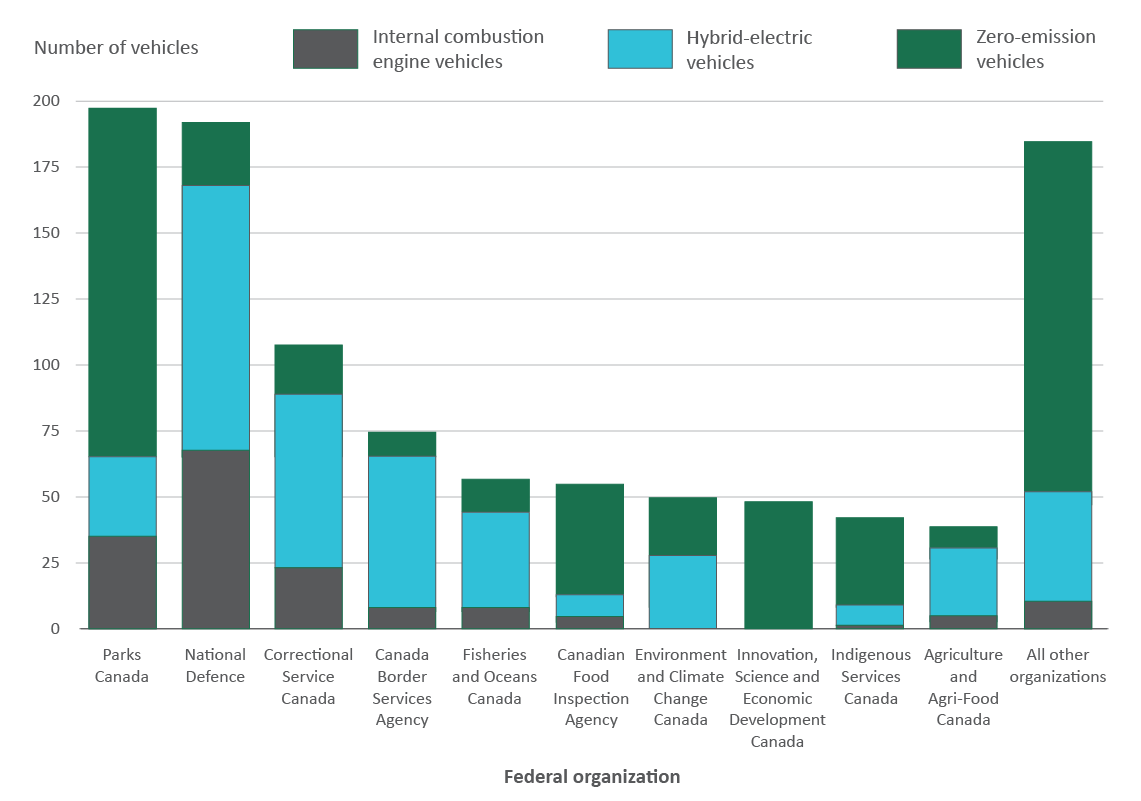
Figure 6 - Text version
The bar chart shows the number of zero-emission, hybrid-electric and internal combustion vehicles purchased by federal organization in 2023-24, where the purchase target was applicable.
| Federal organization | Number of internal combustion engine vehicles | Number of hybrid-electric vehicles | Number of zero-emission vehicles |
|---|---|---|---|
| Parks Canada | 37 | 30 | 130 |
| National Defence | 70 | 97 | 25 |
| Correctional Service Canada | 24 | 67 | 16 |
| Canada Border Services Agency | 10 | 55 | 9 |
| Fisheries and Oceans Canada | 8 | 36 | 15 |
| Canada Food Inspection Agency | 5 | 10 | 43 |
| Environment and Climate Change Canada | 1 | 27 | 22 |
| Innovation, Science and Economic Development Canada | 0 | 0 | 48 |
| Indigenous Services Canada | 2 | 7 | 33 |
| Agriculture and Agri-Food Canada | 6 | 26 | 7 |
| Transport Canada | 6 | 0 | 29 |
| Natural Resources Canada | 2 | 3 | 26 |
| Royal Canadian Mounted Police | 3 | 23 | 3 |
| Public Services and Procurement Canada | 0 | 2 | 15 |
| National Research Council Canada | 0 | 0 | 15 |
| Health Canada | 0 | 0 | 10 |
| Employment and Social Development Canada | 0 | 2 | 5 |
| Shared Services Canada | 0 | 7 | 0 |
| Canada Revenue Agency | 0 | 0 | 4 |
| Canadian Space Agency | 0 | 1 | 2 |
| Crown-Indigenous Relations and Northern Affairs Canada | 0 | 1 | 0 |
| Public Safety Canada | 0 | 1 | 0 |
Key results
- As of the end of fiscal year 2023-24, 18.9% of the Government of Canada’s conventional light-duty fleet was green: 7.3% zero-emission vehicle (ZEV) and 11.6% hybrid-electric vehicle (HEV). National Defence has the largest conventional fleet and the most HEVs and ZEVs. Of the top ten largest fleet owning federal organizations, Transport Canada has the highest percentage of HEVs and ZEVs.
- In 2023-24, 83% of the Government of Canada’s new purchases of light-duty vehicles were green (44.5% ZEVs, 38.5% HEVs) in segments where suitable options were available. Federal organizations purchased and received a total of 457 ZEVs and 395 HEVs.
- The pace of fleet greening has accelerated since the recent global supply chain disruptions and delivery delays. In 2023-24, federal organizations purchased more vehicles overall, and more than doubled ZEV purchases compared to 2022-23. The availability of larger vehicle types (vans, pickups), which make up the majority of the light-duty fleet (61%) remains limited. ZEV purchases are expected to continue increasing as more suitable options become available.
More information
- The Centre for Greening Government continues to work with Public Services and Procurement Canada, Natural Resources Canada (NRCan) and federal fleet-owning organizations to improve the procurement and policy tools available to guide federal organizations in their actions to meet the targets outlined in the Greening Government Strategy. These improvements include:
- the development of tools for forward-looking market analysis and to calculate the total cost of ownership, which allow federal organizations to assess future availability and compare the total costs of purchasing and operating green vehicles to the costs for internal combustion engine vehicles
- the development of guidance for strategic fleet green planning, enabling federal organizations to outline their transition plans to achieve the targets
- enhanced green vehicle procurement options for light-, medium- and heavy-duty vehicles
- reporting tools for GHG emissions and vehicle inventories that allow federal organizations to organize the data required to report progress toward purchasing ZEVs
- NRCan’s federal vehicles and fleets page, which provides information about fleet telematics analysis and assessments of the readiness of charging infrastructure
- Greening Government Fleets, which is a guide published by NRCan
Purchases of clean electricity
In Canada, provinces and territories determine the mix of fuels used to generate electricity. Some fuels, such as coal and natural gas, emit greenhouse gases (GHGs) while others, such as hydro, wind and solar, do not. As a result, the proportion of electricity consumed by federal buildings that is generated from clean (non-emitting) sources varies by jurisdiction. Furthermore, the Government of Canada purchases renewable energy certificates (RECs) for some of its electricity consumption.
A REC is an instrument that certifies ownership of one megawatt-hour (MWh) of electricity generated from renewable sources, in addition to the associated reduction in emissions. RECs provide a financial incentive to generators to add more renewable electricity supply (such as wind and solar) to the grid, which may displace sources that emit GHGs. The Government of Canada prefers to buy RECs or clean electricity in the province where the electricity is consumed.
The Government of Canada:
- consumed 2,610 gigawatt hours (GWh) of electricity in 2023-24
- purchased 227 GWh of RECs to compensate for the emissions from electricity consumed in provinces with grids that are emission intensive
About 87% of the electricity consumed by the Government of Canada was from non-emitting sources, including the impact of purchasing RECs. Figure 8 accounts for the purchase of RECs in the calculation of clean electricity as a percentage of total electricity consumed.
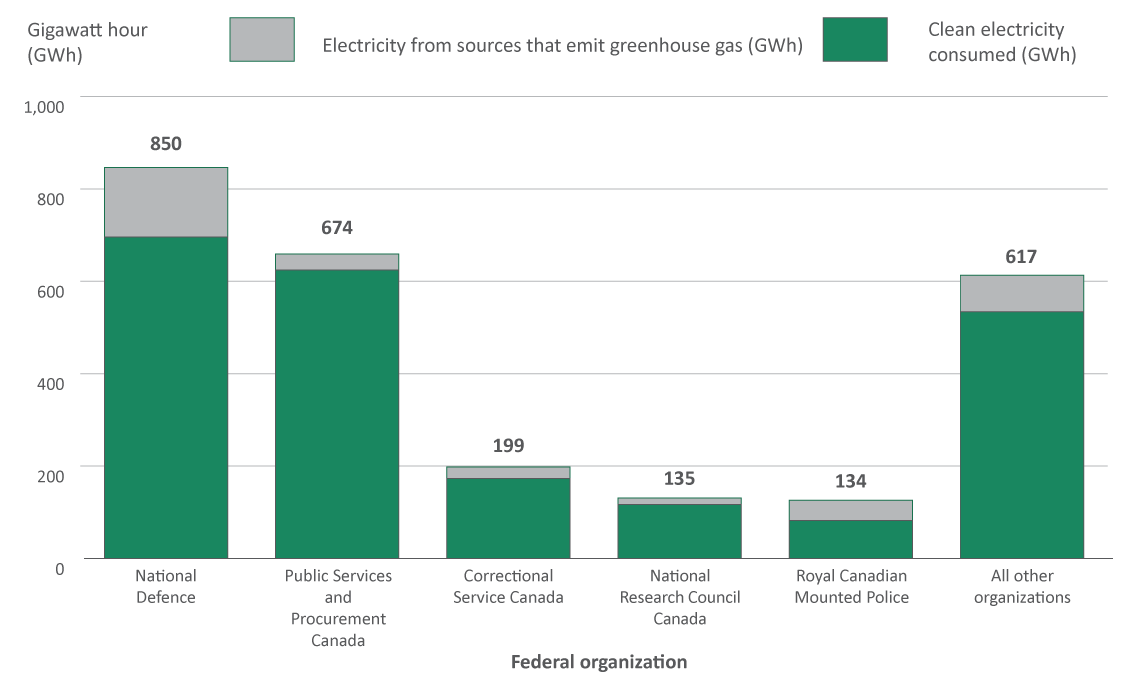
Figure 7 - Text version
The bar graph shows the proportion of electricity consumed from emitting and non-emitting sources for each of the top 5 consuming organizations. A single bar shows the combined consumption proportions for the remaining organizations.
| Federal organization | Total electricity consumed (GWh) | Clean electricity consumed (GWh) | Electricity consumed from sources that emit greenhouse gas (GWh) |
|---|---|---|---|
| National Defence | 850 | 699 | 151 |
| Public Services and Procurement Canada | 674 | 638 | 36 |
| Correctional Service Canada | 199 | 177 | 22 |
| National Research Council Canada | 135 | 121 | 14 |
| Royal Canadian Mounted Police | 134 | 94 | 40 |
| All other organizations | 617 | 540 | 77 |
Note: Totals may not add due to rounding.
Figure 8 includes the purchase of RECs in calculating the clean electricity consumed as a percentage of the total electricity consumed by the federal government in each province or territory.
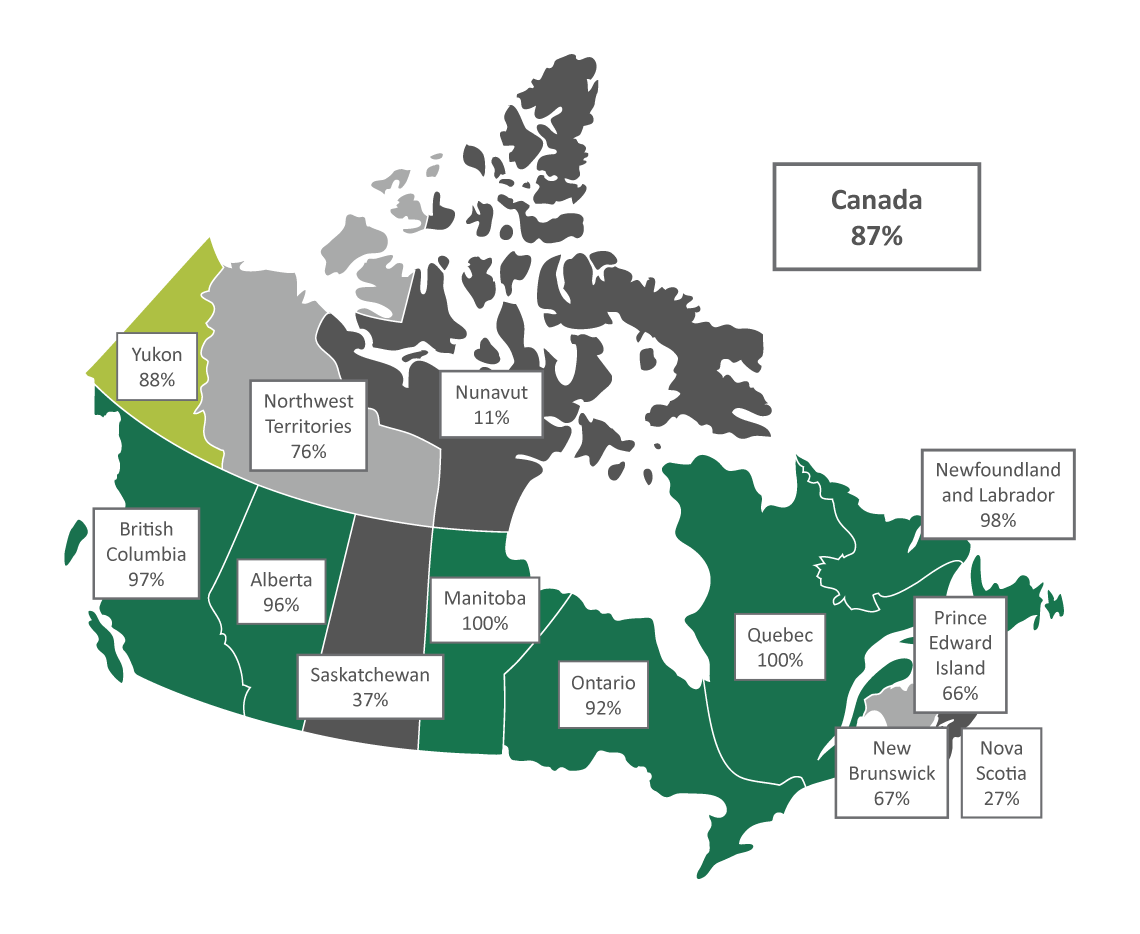
Figure 8 - Text version
The map of Canada shows the regional distribution of the percentage of electricity consumption from non-emitting sources of electricity generation in fiscal year 2023-24.
| Jurisdiction | Clean electricity consumed as a percentage of the total electricity consumed by the federal government |
|---|---|
| Manitoba | 100% |
| Quebec | 100% |
| Newfoundland and Labrador | 98% |
| British Columbia | 97% |
| Alberta | 96% |
| Ontario | 92% |
| Yukon | 88% |
| Northwest Territories | 76% |
| New Brunswick | 67% |
| Prince Edward Island | 66% |
| Saskatchewan | 37% |
| Nova Scotia | 27% |
| Nunavut | 11% |
| Canada | 87% |
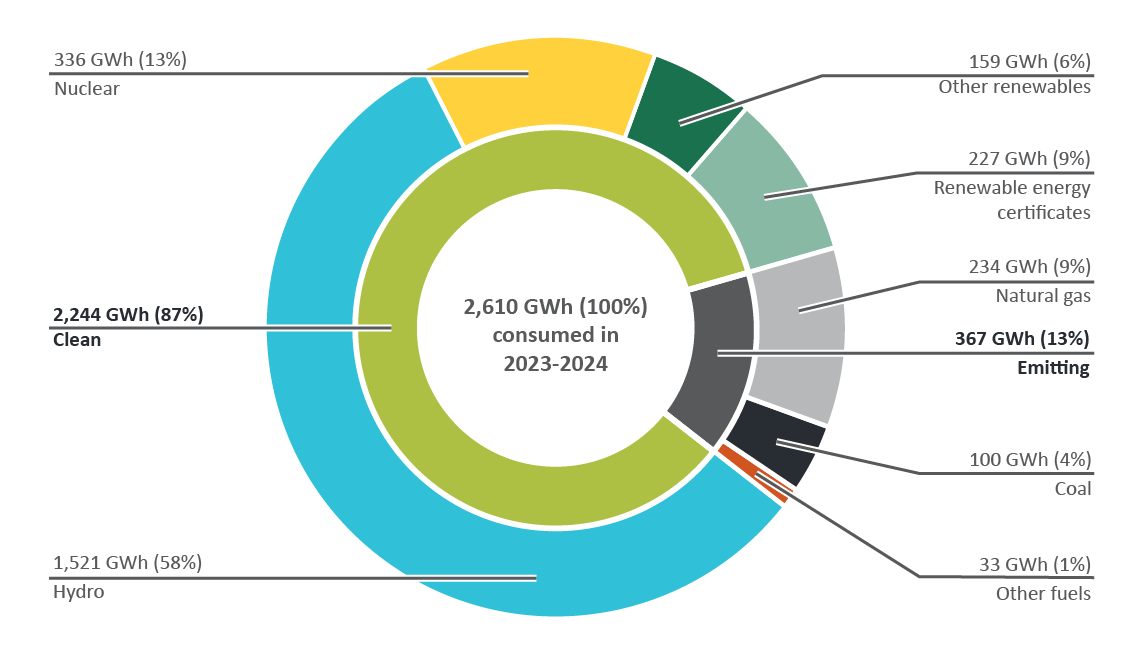
Figure 9 - Text version
The inner circle of the sunburst diagram shows the proportion of electricity consumption from emitting and non-emitting sources. The outer circle further breaks down the emitting and non-emitting segments by generation energy type.
| Source of electricity by type | GWh consumed by the federal government | Percentage of total electricity consumed by the federal government |
|---|---|---|
| Clean sources | 2,244 | 87% |
Hydro |
1,521 | 58% |
Nuclear |
336 | 13% |
Other renewables |
159 | 6% |
Renewable energy certificates |
227 | 9% |
| Emitting sources | 367 | 13% |
Natural gas |
234 | 9% |
Coal |
100 | 4% |
Other fuels |
33 | 1% |
| Total | 2,610 | 100% |
Key results
- 87% of the electricity consumed by Government of Canada operations was generated from clean sources, including the purchase of renewable energy certificates (RECs).
- Before considering the impact of REC purchases, electricity consumed in Manitoba, Quebec, British Columbia, and Newfoundland and Labrador was the cleanest. Electricity in Nunavut, Nova Scotia, Alberta and Saskatchewan was the most emissions intensive given the high proportion of electricity generation from fuels that emit greenhouse gas (GHG). However, the purchase of RECs in the latter two provinces significantly reduced GHG emissions from electricity use.
- 77% of electricity consumed by the federal government was generated from clean sources, such as nuclear, hydro, and other renewables, excluding the impact of RECs. Between 2022-23 and 2023-24, generation from nuclear, concentrated in Ontario, was down 43% while generation from natural gas was up 38% across the country.
More information
RECs are market instruments that certify ownership of one megawatt-hour (MWh) of electricity generated from renewable sources in addition to the associated reduction in emissions. The purchase of RECs encourages renewable electricity generators to feed more power into the grid, which may displace the generation of electricity from sources that emit GHGs, such as coal and natural gas.
Procurement training
As outlined in the Greening Government Strategy, the Government of Canada is committed to lessening the impacts on the environment caused by government procurement of goods and services. As a part of efforts to green procurement, the Canada School of Public Service launched a course for procurement officers on Green Procurement (COR405), which covers the Policy on Green Procurement and how to apply its principles during the procurement process.
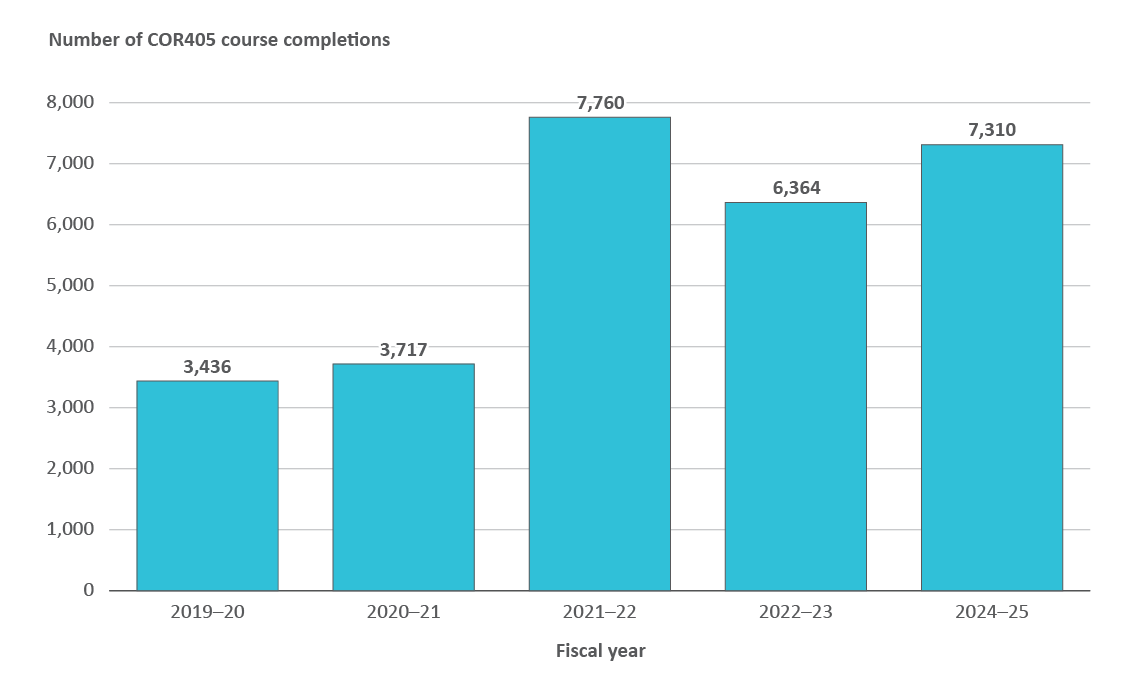
Figure 10 - Text version
The bar chart shows the number of COR 405 course completions for each year from fiscal year 2019-20 to 2023-24.
| Fiscal year | Number of COR405 course completions |
|---|---|
| 2019–20 | 3,436 |
| 2020–21 | 3,717 |
| 2021–22 | 7,760 |
| 2022–23 | 6,364 |
| 2023–24 | 7,310 |
Refer to the Green procurement course and the Policy on Green Procurement for more information.
Other procurement
Shared procurement instruments
Shared procurement instruments, such as Standing Offers and Supply Arrangements (SOSAs), are key tools that the federal government uses to obtain best value for Canadians. Integrating environmental considerations into SOSAs ensures that organizations can easily make environmentally preferable choices. A key indicator demonstrating that the federal government is achieving greener procurement is the number of SOSAs that include criteria that address environmental considerations, including reductions in GHG emissions and plastic waste, as well as other environmental impacts. As of February 2024, 3,252 SOSAs are identified as green.
For more information, refer to:
- the Federal Sustainable Development Strategy
- the Green procurement course
- the sustainable development strategies for each organization
3,252
Standing offers and supply arrangements with environmental considerations
As of February 2024
Disclosure of emissions produced by suppliers
The Government of Canada will reduce its supply chain emissions by inducing suppliers to adopt a science-based target in line with the Paris Agreement, while also publicly disclosing their GHG emissions and environmental performance.
Effective April 1st, 2023, the Standard on the Disclosure of Greenhouse Gas Emissions and the Setting of Reduction Targets (the Standard) under the Policy on Green Procurement came into force.
This new Standard applies to all federal organizations that are subject to the Policy on Green Procurement and requires that procurements over $25M induce suppliers to disclose their greenhouse gas emissions and set reduction targets in line with the Paris Agreement as part of participating in the Net-Zero Challenge or in an equivalent initiative or standard.
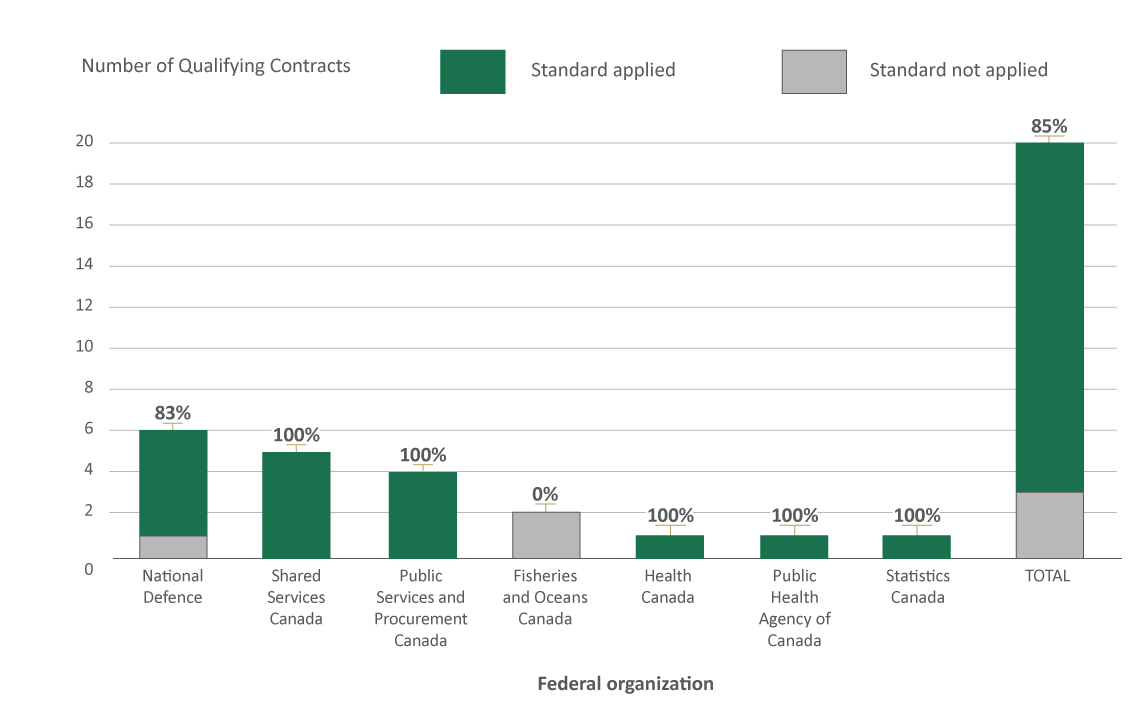
Figure 11 - Text version
The bar chart shows the number of qualifying contracts that applied and did not apply the Standard by federal organization in 2023-24.
| Federal organization | Number of contracts where the Standard was applied | Number of contracts where the Standard was not applied | Percentage compliance |
|---|---|---|---|
| National Defence | 5 | 1 | 83% |
| Shared Services Canada | 5 | 0 | 100% |
| Public Services and Procurement Canada | 4 | 0 | 100% |
| Fisheries and Oceans Canada | 0 | 2 | 0% |
| Health Canada | 1 | 0 | 100% |
| Public Health Agency of Canada | 1 | 0 | 100% |
| Statistics Canada | 1 | 0 | 100% |
| Total | 17 | 3 | 85% |
For more information, refer to:
Construction materials
Under the Greening Government Strategy, the Government of Canada is committed to reducing the environmental impact of construction materials. The government has mandated the disclosure of the embodied carbon of structural materials in major construction projects. As of December 2022, the embodied carbon in ready-mix concrete used in major construction projects must be disclosed.
By 2025, the government also aims to:
- reduce the embodied carbon in structural materials by 30%
- conduct life-cycle assessments for major buildings and infrastructure projects
To address downstream impacts related to construction materials, the government has committed to diverting at least 90% of all construction and demolition waste from landfills. The goal is to divert 100% of such waste by 2030. Data and estimates on the impact of low-carbon construction materials will be published on this page when the data and estimates become available after the 2024-25 reporting cycle.
For more information, refer to:
Low-carbon fuels
The Low-Carbon Fuel Procurement Program:
- was launched with funding allocated in Budget 2021
- will start funding purchases of low-carbon fuel in 2023–24
The program is intended to support departments in the purchasing of drop-in, low-carbon-intensity liquid fuels for the federal air and marine fleets. The program will support the purchase of approximately 200 million litres of drop-in, low-carbon-intensity fuels by the end of 2030–31.
3 million litres
Neat low carbon fuel purchased in 2023-24
Almost all used in National Defence and
Coast Guard marine fleets
8 kt CO2e
Emissions avoided in 2023-24
Equivalent of 3% of total marine national safety and security fleet emissions
For more information, refer to the:
Office leases
The Government of Canada aims to:
- reduce the carbon footprint of its leased office space
- mitigate the impacts of climate change
To achieve these aims, the government has mandated that 75% of new leases and lease renewals must be for net-zero emissions, climate-resilient buildings starting in 2030. Reporting on energy use, GHG emissions, water use and waste generation will be mandatory for domestic spaces over 500 m2 in 2023, with more stringent reporting requirements coming into effect in the future.
Data and estimates on the impact of net-zero floor space in offices will be published on this page when the data and estimates become available.
For more information, refer to: